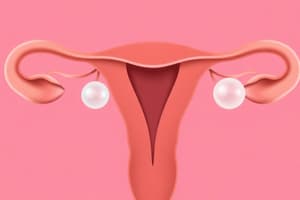Podcast
Questions and Answers
The ovarian cycle consists of only two phases: the follicular phase and the luteal phase.
The ovarian cycle consists of only two phases: the follicular phase and the luteal phase.
False (B)
The zona pellucida surrounds the oocyte and provides pores through which processes of granulosa cells can interact with the oocyte surface.
The zona pellucida surrounds the oocyte and provides pores through which processes of granulosa cells can interact with the oocyte surface.
True (A)
The growth of primary follicles that occurs before puberty is hormone-related and controlled by intraovarian factors.
The growth of primary follicles that occurs before puberty is hormone-related and controlled by intraovarian factors.
False (B)
The theca interna and theca externa are two layers of cells present in the growing follicles.
The theca interna and theca externa are two layers of cells present in the growing follicles.
The primordial (primary) follicles contain multiple oocytes surrounded by a single layer of granulosa cells.
The primordial (primary) follicles contain multiple oocytes surrounded by a single layer of granulosa cells.
The growth of follicles up to the antral stage depends solely on follicle-stimulating hormone (FSH).
The growth of follicles up to the antral stage depends solely on follicle-stimulating hormone (FSH).
The formation of the Graafian follicle begins at puberty when luteinizing hormone (LH) and FSH levels start fluctuating with each estrous cycle.
The formation of the Graafian follicle begins at puberty when luteinizing hormone (LH) and FSH levels start fluctuating with each estrous cycle.
A mature Graafian follicle has a diameter of approximately $10$-$20$ millimeters.
A mature Graafian follicle has a diameter of approximately $10$-$20$ millimeters.
The follicular fluid within the Graafian follicle contains progesterone.
The follicular fluid within the Graafian follicle contains progesterone.
During ovulation, the ovum is released along with the surrounding cumulus cells, forming the corona radiata.
During ovulation, the ovum is released along with the surrounding cumulus cells, forming the corona radiata.
Flashcards are hidden until you start studying




